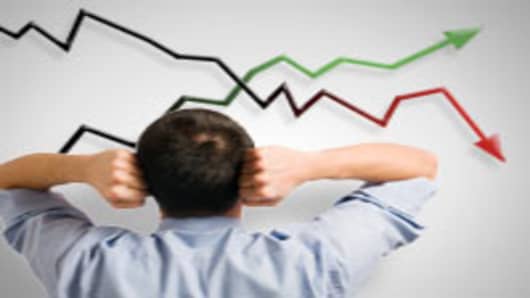Oil’s foray Wednesday above the psychologically important $100-a-barrel line only helped stoke the historical comparisons.
With turmoil permeating the Middle East and threatening to disrupt global supplies, 2011 more and more was starting to resemble 1979, when the US also got caught flat-footed in its response to a crisis in the region.
Yet few were willing to take the parallels a step further and say US economic growth is substantially threatened by the duel stagflationary evils of high unemployment and inflation.
Only Pimco’s Mohamed El-Erian and Richard Cochinos, forex strategist at Bank of America Merrill Lynch, took the plunge.
In a note to clients Wednesday, Cochincos wrote:
The crisis in Libya continues to drive the market….If the uncertainty in the Middle East stays, the (Treasury) bull-flattening likely will continue in the near term. However, the correlation will break down at a point when the market starts to be concerned about stagflation in the sense that the high oil price sharply slows down the economy but the costs will drive inflation higher.
In an interview on CNBC, El-Erian warned of a “wind of stagflation” where higher oil prices will “take purchasing power way from the consumer.”
But few traders and economists are joining the chorus.
The employment picture is improving, they say, but the wage pressures that normally drive inflation are not present.
Moreover, economists such as Deutsche Bank’s Joe LaVorgna, who has been warning about inflation pressures but not about stagflation, says this time is different because the economy is growing and monetary policy remains accommodative.
Stagflation is “something certainly to be mindful of,” he said an interview, “however, and here’s the thing: Monetary policy is very accommodative. That wasn’t the case in the previous five recessions. The fed was actually tightening rates and then the oil shock reinforced the downturn.”
But doesn’t easy Fed policy actually stoke inflation by making dollar-denominated commodities cheaper to buy in the global marketplace?
“It does, but the dollar’s only been drifting lower. It’s not that far from the ’08 lows, which were not that different from where you bottomed in ’95,” LaVorgna said. “I don’t think the dollar is really driving commodities here. It’s a factor, but not the primary driver.”
Maybe so, but when you tally up all the crosswinds whipping through the markets these days—Mideast trouble, weak housing numbers, the horribly manipulated jobs numbers—it’s nigh on impossible not to think a wicked storm is brewing.
David Kotok, of Cumberland Advisors, warned that the Mideast crisis is “nowhere near over.” He veers from the inflation or stagflation story by speculating that consumers may simply cut back on buying gas and thus blunt inflation effects.
All the same, though, he said he’s moving to his highest cash allotments in more than two years while overweighting energy and underweighting consumer discretionary. If correct, the latter move would be an ominous sign for a continued surge in the equity markets.
“We think being fully invested when there is a shooting war in a major oil producing country is folly,” Kotok told clients.
Julian Jessop, an analyst at Capital Economics, which thinks oil prices eventually will head lower this year, nevertheless warns about the impact a further rise in gas prices could have on the economy.
He estimates that a 10 percent rise in gas prices (hardly an outlandish scenario with current trends in place) would cost US consumers $40 billion, or 0.4 percent of real incomes.
“This could wipe out much of the boost from the payroll tax cut, even before taking account of higher food prices,” Jessop wrote, adding that the firm “will continue to monitor these effects” as the Middle East saga plays out.
For investors, the calculus gets tricky.
Though a poor 5-year auction knocked the wind out of a brief Treasurys rally, US debt, not the dollar, was getting the safety bid this week from the geopolitical turmoil. That could be an assumption on investors’ parts that if the US sees inflation it will be less than its global neighbors and drive the Fed to print more money to prop up the economy, thus keeping interest rates low and helping Treasurys.
While that may be a bit of gummy economics, Kim Rupert, managing director of US fixed income trading at Action Economics, says she might be cutting Treasurys exposure “but not with both hands. As we’ve seen this week, tensions and unrest and a safe-haven bid can pretty much appear when you least expect it.”
As for the equity markets, Wednesday’s selloff fed into pullback expectations, but most traders were figuring the move would be temporary.
“I still think there’s room to run,” said Ben Lichtenstein at TradersAudio. “There’s still a lot of pressure on this market. But I also need to remind myself of the resilience that has been displayed over the last couple of years.”
______________________________________
Questions? Comments? Email us at NetNet@cnbc.com
Follow Jeff @ twitter.com/JeffCoxCNBCcom
Follow NetNet on Twitter @ twitter.com/CNBCnetnet
Facebook us @ www.facebook.com/NetNetCNBC



